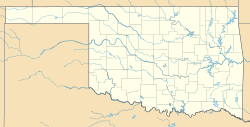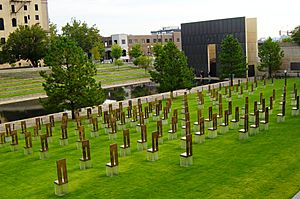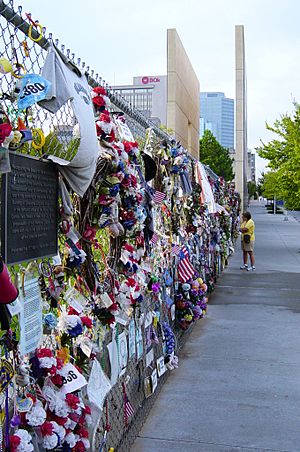Oklahoma City National Memorial facts for kids
Quick facts for kids |
|
|
Oklahoma City National Memorial & Museum
|
|
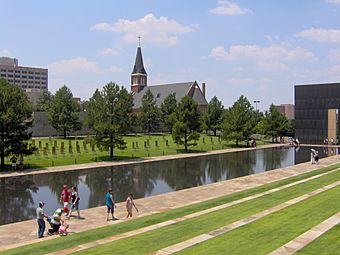
Oklahoma City National Memorial pictured in 2006
|
|
| Location | 620 North Harvey Avenue Oklahoma City, Oklahoma 73102 |
|---|---|
| Area | 3.3 acres (1.3 ha) 3.12 acres (1.26 ha) federal |
| Built | 1997–2001 |
| Website | Oklahoma City National Memorial & Museum |
| NRHP reference No. | 01000278 |
| Added to NRHP | October 9, 1997 |
The Oklahoma City National Memorial is a special place in Oklahoma City, Oklahoma, USA. It honors everyone affected by a terrible event called the Oklahoma City bombing on April 19, 1995. This memorial remembers the people who died, those who survived, and the brave rescuers who helped.
The memorial stands where the Alfred P. Murrah Federal Building once was. This building was badly damaged in the bombing and later taken down to make way for this important site.
President Bill Clinton officially approved the national memorial on October 9, 1997. It was added to the National Register of Historic Places on the same day. The Oklahoma City National Memorial Foundation manages the site, with help from National Park Service staff. They help visitors understand the memorial's meaning.
The outdoor part of the memorial opened on April 19, 2000, which was five years after the bombing. The museum opened a few months later, on February 19, 2001.
Contents
A Sad Day: The Oklahoma City Bombing
On April 19, 1995, a man named Timothy McVeigh parked a truck filled with explosives in front of the Alfred P. Murrah Federal Building. The bomb exploded, causing a huge amount of damage. A total of 168 people lost their lives, including many children. The entire front of the building was destroyed.
After this tragic event, the city's mayor, Ron Norick, created a group to plan a lasting memorial. This group wanted an outdoor memorial, a museum, and an institute to help prevent future acts of violence. Many people submitted ideas for the memorial. In July 1997, a design by Hans and Torrey Butzer was chosen.
In October 1997, President Bill Clinton signed a law to create the Oklahoma City National Memorial. It cost about $29.1 million to build everything. The government and the state of Oklahoma helped pay for it, and people also donated over $17 million.
The Outdoor Symbolic Memorial was dedicated on April 19, 2000. The Memorial Museum opened on February 19, 2001. Since it opened, over 4.4 million people have visited the outdoor memorial, and 1.6 million have visited the museum. About 350,000 people visit each year.
Exploring the Memorial Features
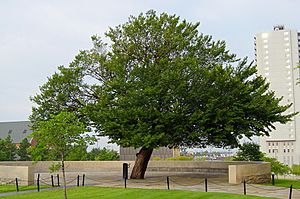
The Outdoor Symbolic Memorial covers about 3.3 acres. It is open day and night for visitors. Here are some of its important parts:
The Gates of Time
These are two tall bronze gates that mark the entrance to the memorial. They represent the exact moment of the bombing. The eastern gate shows "9:01," which stands for the last moment of peace. The western gate shows "9:03," representing the first moment of recovery. Both times are written on the inside of the gates, facing each other across the Reflecting Pool.
The outside of each gate has a special message:
We come here to remember Those who were killed, those who survived and those who changed forever. May all who leave here know the impact of violence. May this memorial offer comfort, strength, peace, hope and serenity.
The Reflecting Pool
This pool has a thin layer of water flowing over shiny black granite. It runs through the center of the memorial where Fifth Street used to be. As you look into the water, you can see your reflection. This is meant to show you "someone changed forever by what happened here."
The Field of Empty Chairs
There are 168 empty chairs made of glass, bronze, and stone. Each chair stands for one person who died in the bombing. The name of each person is carved into the glass base of their chair. The chairs are placed where the Murrah Building once stood.
They are arranged in nine rows, just like the nine floors of the building. Each chair is on the row that matches the floor where that person was when the bomb exploded. The chairs are also grouped to show where the building was most damaged. Five chairs on the far west side represent people who died but were not inside the Murrah Building. Nineteen smaller chairs represent the children who were killed. Three unborn babies are also remembered on their mothers' chairs.
The Survivors' Wall
The only parts of the original Murrah Building still standing are the south and east walls. These are called the Survivors' Wall. This wall has granite panels from the building. It lists the names of over 600 people who survived the bombing, many of whom were hurt.
The Survivor Tree
This American elm tree was badly damaged by the bomb but managed to live. It stands on the north side of the memorial. The Survivor Tree has become a symbol of hope and strength. Every year, thousands of seeds from this tree are planted. The young trees are then given away on the anniversary of the bombing. Many Survivor Trees now grow in places all over the U.S.
The Memorial Fence
After the bombing, a tall chain link fence was put up to protect the site. For over four years, visitors left stuffed animals, poems, and other items on this fence as tributes. During the memorial's construction, 210 feet of the fence were moved to the west side, known as the 'healing' side. Visitors can still leave small items on this part of the fence. These items are collected and stored.
The Rescuers' Orchard
Around the Survivor Tree, there is a grove of trees like Oklahoma redbuds and other types of trees. These trees represent the brave rescuers who came to help after the bombing. The trees from other places symbolize the rescuers who came from outside Oklahoma.
The Children's Area
After the bombing, children from all over the United States and Canada sent over 5,000 hand-painted tiles to Oklahoma City. Some of these tiles are displayed on a wall in the Children's Area. There are also chalkboards where children can draw and share their feelings. This area is located north of the 9:03 gate, on the west side of the Museum.
The Oklahoma City National Memorial Museum
The Journal Record Building, located north of the memorial, now houses the Oklahoma City National Memorial Museum. Inside, you can find many exhibits and artifacts that tell the story of the Oklahoma City bombing.
Alfred P. Murrah Federal Building Plaza
Just south of the Field of Empty Chairs is a raised area called the Alfred P. Murrah Federal Building Plaza. This was part of the original federal building and had a garden and seating. There was even a playground for a daycare center. Visitors can walk across this plaza, where the original flagpole still flies the American flag.
Nearby Memorials
Two churches across the street from the Murrah Building were also badly damaged. Both churches were repaired and built their own memorials, which are open to the public.
Heartland Chapel
Across from the 9:01 gate is an open-air wooden chapel built by the First United Methodist Church of Oklahoma City. Its altar is made from church stones damaged in the bombing. The Jewish community helped a lot with funding this chapel.
And Jesus Wept
Across from the 9:03 gate is a sculpture of Jesus weeping. It was put there by St. Joseph's Catholic Church. Jesus faces away from the damaged area, covering his face. In front of the sculpture is a wall with 168 gaps, representing the empty spaces left by each life lost.
See also
 In Spanish: Monumento Conmemorativo Nacional de Oklahoma City para niños
In Spanish: Monumento Conmemorativo Nacional de Oklahoma City para niños


